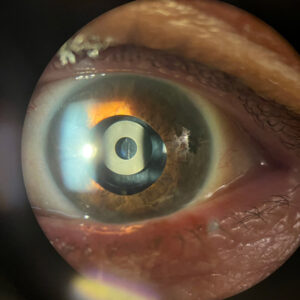ASCRS News
July 2021

ASCRS Grand Rounds, a monthly CME opportunity, is hosted in partnership with major academic institutions and features two challenging cases with panel discussions. The following is a recap of the latest cases presented in the series. For more on how these cases were diagnosed and treated, watch the full videos at ascrs.org/clinical-education/grand-rounds.
Gavin Herbert Eye Institute, University of California, Irvine
Case 1: Catherine Sheils, MD, PGY-3, discussed a case involving a patient with high expectations. The patient was a 67-year-old female with narrow angles who had laser peripheral iridotomies in both eyes. In a cataract evaluation she said she couldn’t watch TV, drive, or read and stated that even with glasses, which she said she couldn’t tolerate, she couldn’t see. Her vision in the right eye was 20/60-2 and 20/50 in the left. Dr. Sheils said there was no improvement in visual acuity with a manifest refraction or with her glasses. Anterior segment and fundus exams were normal and her cataract was graded as a 2+ NS. Tomography revealed more astigmatism in the right eye than what was recorded by the IOLMaster (Carl Zeiss Meditec).
Case 2: Aman Mittal, MD, cornea and refractive surgery fellow, shared a case of a 59-year-old patient who presented for a baseline assessment before starting a new medication that could worsen dry eye. He denied baseline symptoms of dry eye and his vision was stable since his last exam 8 years prior. Medical history included multiple myeloma, and he had strabismus that was treated with surgery. His manifest refraction was myopic. Slit lamp examination showed mild MGD in both eyes with no evidence of dry eye. He was advised to start warm compresses and to return to clinic 6 weeks after starting his new medication. Visual changes and corneal effects were observed after starting the new medication.
Bascom Palmer Eye Institute
Case 1: Masako Chen, MD, cornea and external diseases fellow, presented a case of a 36-year-old male with blurry vision (right eye more than the left) for 2 years. He had a history of Marfan’s syndrome, congenital ptosis, entropion repair, and multiple eyelid surgeries. The right eye’s BCVA was E at 1 foot. He had superior scleral show, a dense, central leukoma with extensive and deep neovascularization, and 3 mm of lagophthalmos. Anterior segment OCT revealed an irregular epithelium and subepithelial reflectivity that extended into the stroma. The left eye’s BCVA was 20/60 with a corneal gas permeable lens. The left eye presented with similar OCT findings as the right.
Case 2: Jason Fan, MD, PhD, PY-2, discussed a case that involved a 52-year-old woman who presented with left eye pain and redness for 3 weeks. Past medical history included childhood hearing loss with a later cochlear implant, hypertension, and rheumatoid arthritis. She was on several medications including atenolol, losartan, methotrexate, and prednisone. Visual exam revealed 20/25 VA in both eyes. Physical exam showed superior nodular scleritis involving the limbus and focal/superficial scleral melt in the left eye and 2+ punctate epithelial erosions in both eyes.
University of California, San Francisco
Case 1: The case “Cornification & the Cornea” was presented by Zeeshan Haq, MD, PGY-4, involving a 43-year-old man with congenital lamellar ichthyosis with a non-healing corneal abrasion in his right eye. The patient reported scratching the skin near his right eye prior to onset of symptoms, which included reduced vision, redness, and tearing for a few days that worsened over time. The patient initially presented to the ER. The patient had previously been seen by dermatology and had used treatments for his skin condition (emollients and lactic acid). His ocular history included exposure keratopathy with a previous tarsorrhaphy in his left eye due to a corneal ulcer. The patient had a social history of living in a residential hotel, active smoking, and prior crystal meth use. His vision was count fingers at 3 inches in the right eye and 20/60, pinhole 20/30 in the left. His right eye had upper and lower lid cicatricial ectropion with margin thickening, keratinization, and madarosis. This eye also had lagophthalmos, diffuse conjunctival injection, no corneal centration, inferocentral corneal ulcer with significant infiltrate and thinning, hypopyon, hazy iris details, and no view to the posterior segment.
Case 2: Benyam Kinde, MD, PGY-3, discussed the case of a 56-year-old patient with a history of LASIK 20 years prior. She was referred for possible post-LASIK ectasia evaluation after slowly progressive blurry vision in her right eye. She increasingly now relies on contact lenses. BCVA in the right eye was 20/30. Her examination showed a 2+ NS cataract and a posterior staphyloma. Corneal topography was consistent with a history of myopic LASIK.
Case Western Research University/University Hospitals
Case 1: Lily Kim Hipp, MD, PGY-3, presented a case involving an 85-year-old woman who was referred after 6–8 weeks of intermittent vision loss. Prior to her visit, she was able to count fingers at 1 foot in her right eye, which had an IOP of 27 mm Hg. The patient had cataract surgery in both eyes a decade prior and was using timolol sporadically due to dementia. Her IOP was 21 mm Hg and vision was 20/25-2. Slit lamp exam showed the IOL was dislocated nasally with the haptic-optic junction posterior to the capsulorhexis and with a transillumination defect temporally of the iris. The patient had 1+ corneal endothelial pigment and 1+ vitreous pigment. After a month of observation, pigment in the anterior chamber increased.
Case 2: Sachin Kalarn, MD, glaucoma fellow, described a case of spontaneous ring choroidal hemorrhage in a 58-year-old woman with a history of multiple myeloma and autologous stem cell transplant 9 days prior to presentation. She was experiencing persistent vomiting and had blurred vision in her right eye, as well as bilateral subconjunctival hemorrhage. She had ABMD, myopia, and was on cyclosporine. Several pertinent medications were noted. The patient could correct to 20/20; myopic refraction was –4.5 D in the right eye, –5 D in the left. Her pupil dilation in the right eye was 5 mm and sluggish, while her left eye was normal. IOP in the right eye was 50 mm Hg. It also had mild microcystic edema. The right eye had a 360-degree subconjunctival hemorrhage with chemosis inferiorly, while her left eye had a superonasal subconjunctival hemorrhage.



